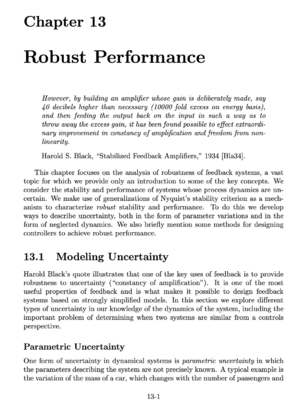Robust Performance
| Prev: Frequency Domain Design | Chapter 13 - Robust Performance | Next: Fundamental Limits |
This chapter focuses on the analysis of robustness of feedback systems, a vast topic for which we provide only an introduction to some of the key concepts. We consider the stability and performance of systems whose process dynamics are uncertain. We make use of generalizations of Nyquist’s stability criterion as a mechanism to characterize robust stability and performance. To do this we develop ways to describe uncertainty, both in the form of parameter variations and in the form of neglected dynamics. We also briefly mention some methods for designing controllers to achieve robust performance.
Contents
- Modeling Uncertainty
- Parametric Uncertainty
- Unmodeled Dynamics
- When Are Two Systems Similar?
- The Vinnicombe Metric
- Stability in the Presence of Uncertainty
- Robust Stability Using Nyquist's Criterion
- Youla Parameterization
- Performance in the Presence of Uncertainty
- Disturbance Attenuation
- Response to Reference Signals
- Design for Robust Performance
- Quantitative Feedback Theory
- Linear Quadratic Control
- $H\relax \p@index \infty $ Control
- The Generalized Stability Margin
- Disturbance Weighting
- Limits of Robust Design
- Further Reading
- Exercises
Teaching MaterialsNone available Additional ExercisesNone available Frequently Asked QuestionsNone available ErrataNone reported |
Python CodeThe following Python scripts are available for producing figures that appear in this chapter. See the software page for more information on how to run these scripts. Additional Information |
